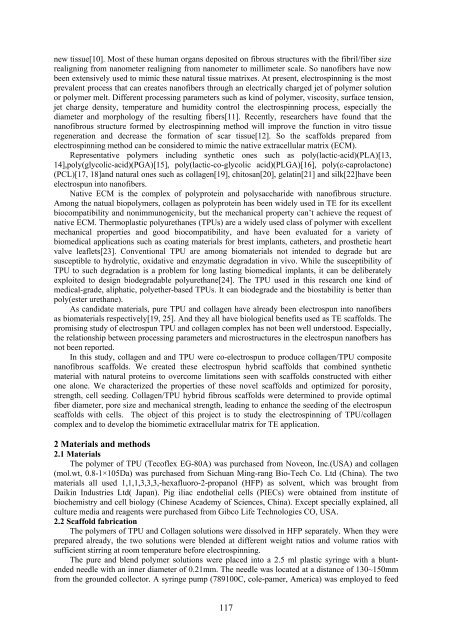Workshop proceeding - final.pdf - Faculty of Information and ...
Workshop proceeding - final.pdf - Faculty of Information and ...
Workshop proceeding - final.pdf - Faculty of Information and ...
Create successful ePaper yourself
Turn your PDF publications into a flip-book with our unique Google optimized e-Paper software.
new tissue[10]. Most <strong>of</strong> these human organs deposited on fibrous structures with the fibril/fiber size<br />
realigning from nanometer realigning from nanometer to millimeter scale. So nan<strong>of</strong>ibers have now<br />
been extensively used to mimic these natural tissue matrixes. At present, electrospinning is the most<br />
prevalent process that can creates nan<strong>of</strong>ibers through an electrically charged jet <strong>of</strong> polymer solution<br />
or polymer melt. Different processing parameters such as kind <strong>of</strong> polymer, viscosity, surface tension,<br />
jet charge density, temperature <strong>and</strong> humidity control the electrospinning process, especially the<br />
diameter <strong>and</strong> morphology <strong>of</strong> the resulting fibers[11]. Recently, researchers have found that the<br />
nan<strong>of</strong>ibrous structure formed by electrospinning method will improve the function in vitro tissue<br />
regeneration <strong>and</strong> decrease the formation <strong>of</strong> scar tissue[12]. So the scaffolds prepared from<br />
electrospinning method can be considered to mimic the native extracellular matrix (ECM).<br />
Representative polymers including synthetic ones such as poly(lactic-acid)(PLA)[13,<br />
14],poly(glycolic-acid)(PGA)[15], poly(lactic-co-glycolic acid)(PLGA)[16], poly(ε-caprolactone)<br />
(PCL)[17, 18]<strong>and</strong> natural ones such as collagen[19], chitosan[20], gelatin[21] <strong>and</strong> silk[22]have been<br />
electrospun into nan<strong>of</strong>ibers.<br />
Native ECM is the complex <strong>of</strong> polyprotein <strong>and</strong> polysaccharide with nan<strong>of</strong>ibrous structure.<br />
Among the natual biopolymers, collagen as polyprotein has been widely used in TE for its excellent<br />
biocompatibility <strong>and</strong> nonimmunogenicity, but the mechanical property can’t achieve the request <strong>of</strong><br />
native ECM. Thermoplastic polyurethanes (TPUs) are a widely used class <strong>of</strong> polymer with excellent<br />
mechanical properties <strong>and</strong> good biocompatibility, <strong>and</strong> have been evaluated for a variety <strong>of</strong><br />
biomedical applications such as coating materials for brest implants, catheters, <strong>and</strong> prosthetic heart<br />
valve leaflets[23]. Conventional TPU are among biomaterials not intended to degrade but are<br />
susceptible to hydrolytic, oxidative <strong>and</strong> enzymatic degradation in vivo. While the susceptibility <strong>of</strong><br />
TPU to such degradation is a problem for long lasting biomedical implants, it can be deliberately<br />
exploited to design biodegradable polyurethane[24]. The TPU used in this research one kind <strong>of</strong><br />
medical-grade, aliphatic, polyether-based TPUs. It can biodegrade <strong>and</strong> the biostability is better than<br />
poly(ester urethane).<br />
As c<strong>and</strong>idate materials, pure TPU <strong>and</strong> collagen have already been electrospun into nan<strong>of</strong>ibers<br />
as biomaterials respectively[19, 25]. And they all have biological benefits used as TE scaffolds. The<br />
promising study <strong>of</strong> electrospun TPU <strong>and</strong> collagen complex has not been well understood. Especially,<br />
the relationship between processing parameters <strong>and</strong> microstructures in the electrospun nan<strong>of</strong>bers has<br />
not been reported.<br />
In this study, collagen <strong>and</strong> <strong>and</strong> TPU were co-electrospun to produce collagen/TPU composite<br />
nan<strong>of</strong>ibrous scaffolds. We created these electrospun hybrid scaffolds that combined synthetic<br />
material with natural proteins to overcome limitations seen with scaffolds constructed with either<br />
one alone. We characterized the properties <strong>of</strong> these novel scaffolds <strong>and</strong> optimized for porosity,<br />
strength, cell seeding. Collagen/TPU hybrid fibrous scaffolds were determined to provide optimal<br />
fiber diameter, pore size <strong>and</strong> mechanical strength, leading to enhance the seeding <strong>of</strong> the electrospun<br />
scaffolds with cells. The object <strong>of</strong> this project is to study the electrospinning <strong>of</strong> TPU/collagen<br />
complex <strong>and</strong> to develop the biomimetic extracellular matrix for TE application.<br />
2 Materials <strong>and</strong> methods<br />
2.1 Materials<br />
The polymer <strong>of</strong> TPU (Tec<strong>of</strong>lex EG-80A) was purchased from Noveon, Inc.(USA) <strong>and</strong> collagen<br />
(mol.wt, 0.8-1×105Da) was purchased from Sichuan Ming-rang Bio-Tech Co. Ltd (China). The two<br />
materials all used 1,1,1,3,3,3,-hexafluoro-2-propanol (HFP) as solvent, which was brought from<br />
Daikin Industries Ltd( Japan). Pig iliac endothelial cells (PIECs) were obtained from institute <strong>of</strong><br />
biochemistry <strong>and</strong> cell biology (Chinese Academy <strong>of</strong> Sciences, China). Except specially explained, all<br />
culture media <strong>and</strong> reagents were purchased from Gibco Life Technologies CO, USA.<br />
2.2 Scaffold fabrication<br />
The polymers <strong>of</strong> TPU <strong>and</strong> Collagen solutions were dissolved in HFP separately. When they were<br />
prepared already, the two solutions were blended at different weight ratios <strong>and</strong> volume ratios with<br />
sufficient stirring at room temperature before electrospinning.<br />
The pure <strong>and</strong> blend polymer solutions were placed into a 2.5 ml plastic syringe with a bluntended<br />
needle with an inner diameter <strong>of</strong> 0.21mm. The needle was located at a distance <strong>of</strong> 130~150mm<br />
from the grounded collector. A syringe pump (789100C, cole-pamer, America) was employed to feed<br />
117
















